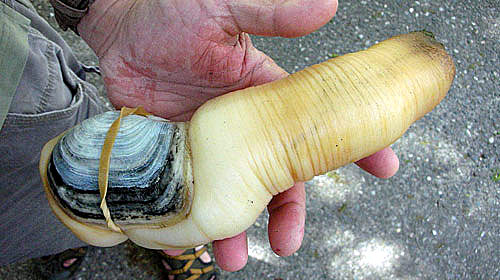
Geoduck clams are shipped live to markets in Asia. (Photo courtesy of the Alaska Department of Fish and Game)
Commercial dive fisheries and a fall Dungeness crab season get underway in Southeast Alaska in October.
The season for geoduck clam diving starts October 1st. The first opening could be October 3rd or 4th depending on testing for the toxins that cause paralytic shellfish poisoning. The region’s guideline harvest level is 702,100 pounds.
The large clams are plucked from the ocean floor and shipped whole and live to overseas markets, if the clams don’t test too high for PSP or inorganic arsenic.
There are a couple of changes for that fishery this year. Past openings have been only from 9 a.m. to 3 p.m., one day a week. The Board of Fisheries last winter approved a one thousand pound weekly harvest limit. Justin Breese is assistant area management biologist with the Alaska Department of Fish and Game in Ketchikan. He said that could be a big change for the fishery.
“So with that new harvest limit, we are going to have a two day fishery so that they can spread out their effort,” Breese said. “There was some concern about safety with people being crammed all together in a small area. With a two day fishery and a thousand pound limit or maybe less I guess depending on the GHL of the area, that’ll allow people to come in and harvest their geoducks and then get out of the way so that there isn’t people trying to dive on top of each other.”
Spreading the harvest over two days may also help boost the price for the clams. Geoducks can live to be over 100 years old and are caught in southern Southeast Alaska near Ketchikan and Prince of Wales Island as well as by Sitka. The state board last winter also approved a limit of two divers making geoduck landings on each vessel.
Openings could be from 8 a.m.-4 p.m. on Wednesdays and Thursdays but will depend on PSP testing, whether areas are opened or not. Most areas are fished on a two-year rotation, with one year on and one year off. About 50-60 divers take part each year and that effort has remained pretty constant. In the past few years the season has stretched into the spring time as divers have worked to slow down their harvest and increase the price for their product.
Meanwhile, sea cucumber diving starts up October 1st with a combined regionwide guideline harvest level of over 1.7 million pounds. Breese said that’s up this year because of another change approved by the Board of Fish.
“There was a change in how the GHLs were calculated, so that there was a more liberalized harvest rate that’s still fairly conservative but it allows for a higher harvest rate on sea cucumbers because they’re shorter lived that geoducks,” Breese said.
The industry group the Southeast Alaska Regional Dive Fisheries Association pushed for that change at board meetings in January and March. SARDFA is concerned with increased predation on clams and cucumbers by the region’s sea otter population and has sought more diving opportunity.
Sea cucumbers are bottom dwelling creatures that resemble their vegetable namesake and are also a delicacy in Asian markets. Diving for cukes happens throughout the region and areas are opened on a rotating basis, once every three years. Effort has also stayed fairly constant with around 180 divers taking part. For the most part the cucumber diving season is over more quickly than the geoduck clam season.
Another commercial fishery, not a dive fishery, also starts up October 1st. The fall season for Dungeness crab in most of the region is open October and November.









